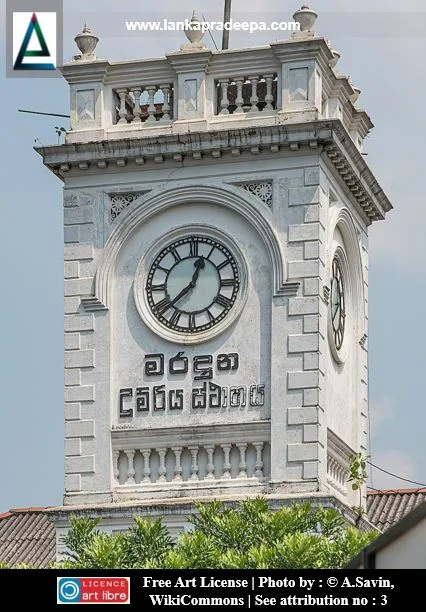
Maradana Railway Station (Sinhala: මරදාන දුම්රිය ස්ථානය) is considered one of the earliest railway stations and primary rail gateways in Sri Lanka (De Silva & Chandrasekara, 2009; Welandawe & Weerasinghe, 2016).
History
In the 19th century, the British rulers commenced the railway service in Sri Lanka for planters to facilitate the transportation of their harvest from inland to the seaport located in Colombo (Kesavan et al., 2015). On 3 August 1858, the then Ceylon Governor, Henry George Ward (1855-1860 A.D.) commenced the construction of the first railway line in the country to be run between Colombo and Ambepussa (Abeysinghe, 2016). After the completion, the first train transportation happened between Colombo and Ambepussa on 27 December 1864 (Abeysinghe, 2016).
Besides the stations at Colombo (presently known as Colombo Terminus Railway Station) and Ambepussa, three more stations at Mahara (present Ragama), Henarathgoda (present Gampaha) and Veyangoda were completed along the railway line in 1866 (CGR, 1964). In 1867, the railway station at Peradeniya was built.
Maradana Railway Station
The history of the Maradana railway station can be traced up to the late 19th century. At the time Maradana was a rural area and only a few buildings were there including the Maradana Mosque and the old army barrack that had been established on the land where the present Maradana Police Station stands. In 1887, a 12 ft x 8 ft sized wooden-framed room was installed at Maradana as a station for issuing rail tickets and on 12 June 1893, it was upgraded to a complete railway station (Manathunga, 2016). The location of the station became more important when the Coastal Line was built in 1897 and as a result of that the station was more developed by constructing the present Maradana railway station building. The construction of the building was commenced in 1905 and declared open in 1908 as the main railway station in the country (De Silva & Chandrasekara, 2009; Manathunga, 2016). The construction works of the building were, however, fully finished in 1910.
Maradana was the main railway station in the country until the Colombo Fort Railway Station was built in 1917 (Manathunga, 2016).
The building
The railway station building has been designed accordance to the English Renaissance style (De Silva & Chandrasekara, 2009). The central tower with four clocks on each side is the most prominent feature of the building (De Silva & Chandrasekara, 2009).
The station
The present railway station consists of 10 platforms.
Platform 1 & 2 - Main line and Puttalam line trains
Platform 3 & 4 - Main line and Puttalam line trains
Platform 5 & 6 - Coastal line trains, rest rooms, toilets, cafeteria, control rooms and offices
Platform 7 & 8 - Coastal line trains
Platform 9 & 10 - Coastal line and Kelani Valley line trains


.
Attribution
1) SL Colombo asv2020-01 img35 Maradana station by A.Savin is under the Free Art License 1.32) SL Colombo asv2020-01 img33 Maradana station by A.Savin is under the Free Art License 1.3
3) SL Colombo asv2020-01 img34 Maradana station by A.Savin is under the Free Art License 1.3
References
1) Abeysinghe, A.H.M.S.P., 2016. ශ්රී ලංකාවේ දුම්රිය කාර්මික පුරාවිද්යාව; නව මානයක් කරා රැගෙන යමු. Puraveda 2016.
2) CGR, 1964. Ceylon Government Railway : One hundred years, 1864-1964, Colombo. p.19.
2) CGR, 1964. Ceylon Government Railway : One hundred years, 1864-1964, Colombo. p.19.
3) De Silva, N.; Chandrasekara, D.P., 2009. Heritage Buildings of Sri
Lanka. Colombo: The National Trust Sri Lanka, ISBN: 978-955-0093-01-4.
p.175.
4) Kesavan, R.A., Chandrakumar, C., Kulatunga, A.K., Gowrynathan, J., Rajapaksha, R.T.D., Senewiratne, R.K.G.D.M. and Laguleshwaran, D., 150 Years of Sri Lankan Railways: Evaluation of the Services from Employee and Customer Perspectives. International Journal of Emerging Technology and Advanced Engineering. Volume 5, Issue 5.
5) Manathunga, S. B., 2016. Pauranika Sthana Saha Smaraka: Kolamba Distrikkaya (In Sinhala). Department of Archaeology (Sri Lanka). ISBN: 955-9159-39-9. pp.61-62.
4) Kesavan, R.A., Chandrakumar, C., Kulatunga, A.K., Gowrynathan, J., Rajapaksha, R.T.D., Senewiratne, R.K.G.D.M. and Laguleshwaran, D., 150 Years of Sri Lankan Railways: Evaluation of the Services from Employee and Customer Perspectives. International Journal of Emerging Technology and Advanced Engineering. Volume 5, Issue 5.
5) Manathunga, S. B., 2016. Pauranika Sthana Saha Smaraka: Kolamba Distrikkaya (In Sinhala). Department of Archaeology (Sri Lanka). ISBN: 955-9159-39-9. pp.61-62.
6) Welandawe, H., Weerasinghe, J., 2016. Urban Heritage in the Western Region Megapolis Planning Project. p.94.
Location Map
This page was last updated on 16 April 2022

